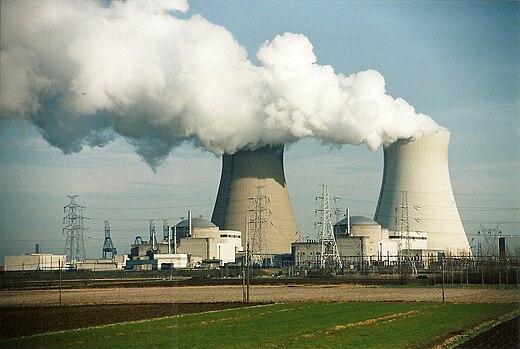
Nuclear power plant
(Image by Wikipedia (commons.wikimedia.org), Author: Emmelie Callewaert) Details Source DMCA
Nuclear power plants when they began being constructed were not seen as running for more than 40 years because of radioactivity embrittling metal parts and otherwise causing safety problems. So operating licenses were limited to 40 years. But in recent decades, the U.S. Nuclear Regulatory Commission has extended the operating licenses of nuclear power plants from 40 years to 60 years and then 80 years, and is now considering 100 years.
"It is crazy," declares Robert Alvarez, a former senior policy advisor at the U.S. Department of Energy and a U.S. Senate senior investigator and now senior scholar at the Institute for Policy Studies. He is an author of the book Killing Our Own: The Disaster of America's Experience with Atomic Radiation.
"No reactor in history has lasted that long ," comments Alvarez. The oldest nuclear power plant in the U.S. was Oyster Creek, five miles south of Toms River, New Jersey, which opened in 1969 and was shut down 49 years later in 2018.
The move is "an act of desperation in response to the collapse of the nuclear program in this country and the rest of the world," he declares.
The nuclear industry and nuclear power advocates in government are "desperately trying to hold on," says Alvarez. With hardly any new nuclear power plants being constructed in the U.S. and the total number down to 94, they seek to have the operating licenses of existing nuclear power plants extended, he says, to keep the nuclear industry alive.
It's a sign of "the end of the messy romance with nuclear power."
The NRC will be holding a webinar on January 21 to consider the extending of nuclear plant operating licenses to 100 years. As its announcement is headed: "PUBLIC MEETING ON DEVELOPMENT OF GUIDANCE DOCUMENTS TO SUPPORT LICENSE RENEWAL FOR 100 YEARS OF PLANT OPERATION."
Nuclear power plant construction has been in a deep depression for some time. Vogtle Units 3 and 4 in Georgia are "the first new nuclear units built in the United States in the last three decades," notes on its website Georgia Power, one of the companies involved in that project. Click Here The cost projection in 2008 to build the two nuclear plants was $14.3 billion. "Now, updated estimates put the total project cost at roughly $28 billion," states Taxpayers for Common Sense, and construction is more than five years behind schedule. Click Here
It's not just the gargantuan price of nuclear power, and the preferability economically today of green, renewable energy led by solar and wind. Nuclear plant construction in the U.S. and much of the world has been in the doldrums because of the Three Mile Island, Chernobyl and Fukushima nuclear power plant catastrophes. People not only don't want to waste their moneythey don't want to lose their lives to nuclear power.
"There is no empirical evidence" to support the notion that nuclear plants can have a century-long life span, says Alvarez. There "is no penciling away the problems of age" of nuclear power plants which operate under high-pressure, high-heat conditions and are subject to radiation fatigue. "The reality of wear-and-tear can't be wished away."
"Who would want to ride in a 100 year-old car?" he asks.
Paul Gunter, director of the Reactor Oversight Project of the organization Beyond Nuclear, says: "The new construction of nuclear power plants is proving to be more expensive and more dubious than ever before. So, the nuclear industry and the NRC are in the process of developing a plan to get these existing aging and inherently dangerous machines to run for 100 years."
"This raises all kinds of problems that have never been addressed," says Gunter.
And the NRC and the U.S. Department of Energy don't want to address them.
(Note: You can view every article as one long page if you sign up as an Advocate Member, or higher).





